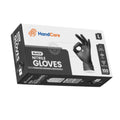If you happen to work in an environment that requires hand protection, or simply looking to safeguard yourself while doing tasks at home, our comparison on nitrile vs latex gloves will set you on the right path to choosing which is best for you or your staff.
It was created specifically for those who are evaluating their options for a reliable way to keep their hands out of harm's way. With that in mind, let's dive into the details that will set these two popular types of gloves apart from each other.
What Are Nitrile Gloves?
Nitrile gloves are a type of disposable glove made from synthetic rubber known as nitrile butadiene rubber. They were originally developed as a solution to the allergic reactions that some individuals experience with natural latex gloves. Nitrile gloves are known for their flexibility, durability, and resistance to chemicals, oils, and punctures.
This makes them a popular alternative to latex gloves in many industries, including healthcare, food handling, and industrial settings. Nitrile gloves are also latex-free and allergy-friendly, offering a reliable option for those with latex sensitivities.
What are Nitrile Gloves Used For?
Nitrile gloves are widely used across various industries due to their high durability and resistance to chemicals and punctures.
They are commonly used in:
- Healthcare Environments
- Hospitals and Clinics
- Food Industry
- Laboratories for handling chemicals
- Industrial sectors
Nitrile gloves are also popular in the automotive industry and for general maintenance work due to their ability to withstand exposure to oils and mechanical wear.
Advantages of Nitrile Gloves
- High Rating for Chemical-Resistance
- Excellent Protection Against Viruses, Pathogens, and Bacteria
- Keeps the Hands Clean and Sanitary
- Hypoallergenic - Best Latex Allergy Alternative
- Nitrile Gloves are Completely Waterproof
- Great Puncture & Tear Resistance Qualities
- If Gloves Happen to Get Punctured it's Clearly Visible
- Created to Have Low Friction Resistance for Easy Removal
- Retains the Needed Tactile Sensitivity
- Conforms to the Hand for a Soft Comfortable Fit
- Durable and Sturdy Protective Glove
- Trusted Source in Many Industries
Disadvantages of Nitrile Gloves
- Slightly Higher Price than Latex - But Well Worth the Price Point
- Supply is Currently Scarce Due to High Demand
- Non-Biodegradable
What Are Latex Gloves?
Latex gloves are a type of disposable glove made from natural rubber latex. They are known for their excellent elasticity, flexibility, and fit, providing a high level of comfort and tactile sensitivity.
Latex gloves are often favored in situations that require precision and dexterity, such as medical procedures or detailed work. However, some individuals may experience allergic reactions to the proteins found in natural latex, which has led to the development of alternatives like nitrile and vinyl gloves.
What are Latex Gloves Used For?
Latex gloves are commonly used in the healthcare industry, especially in medical and dental settings, where a high level of protection and tactile sensitivity is required.
They are ideal for:
- Surgical Procedures
- Patient Examinations
- Laboratories
- Clean Rooms, and for tasks that require handling delicate or small items.
While they provide excellent protection, their use may be limited in environments where individuals have latex allergies.
Advantages of Latex Gloves
- Biodegradable & Environmentally Friendly
- High Tactile Sensitivity
- Protects Against Viruses, Pathogens, and Bacteria
- Highly Elastic and Strong
- Keeps the Hands Clean and Sanitary
- Very Flexible and Comfortable
- Latex Has a Lower Price Point
Disadvantages of Latex Gloves
- Causes Negative Reactions in Those with Latex Allergies
- Provides Little Protection Against Oils, Chemicals and Solvents Compared to Nitrile
- Difficult to See Puncture Holes and Tears
- Powder is Used to Provide Less Friction Which Can Cause Allergic Reactions
What is the Difference Between Nitrile vs Latex Gloves?
Although they are manufactured to serve the same basic purpose - provide a barrier between your skin and harmful or unclean substances, they do differ in various ways. These differences can determine if nitrile or latex would be better for your particular circumstances.
Below you will find a breakdown of qualities that are typically important to the end-user, and how each glove type compares to the other:
Materials
For those of you who may be interested in what elements are used in the manufacturing process, let's take a closer look:
Latex Gloves: The main component that makes up this particular glove is the sap that's derived from rubber trees, also known as Hevea Brasiliensis. The tree sap is comprised of a natural combination of various proteins and lipids. Chemical compounds are added to the sap; this includes ammonia, sulfur, pigments, zinc oxide, antioxidants, and thiurams to accelerate the rubber hardening process, as well as anti-webbing agents.
People tend to like latex gloves because they feel comfortable and like a second skin, which is especially advantageous if you require dexterity when using your gloves. This is one reason surgical gloves tend to be made out of latex.
Nitrile Gloves: They're created from what is called nitrile butadiene rubber, which is a copolymer that's formed by the process of bonding two molecules - butadiene and acrylonitrile. Acrylonitrile boosts the chemical resistance of the gloves, and butadiene makes the gloves strong so that they can resist tears and punctures. Because of made by an artificial process, nitrile is known as a synthetic rubber.
Other elements that are used in the manufacturing process are chlorine and polymer which aids in making the surface less friction-resistant for easy glove removal, as well as water, bleach, calcium carbonate, calcium nitrate, and petroleum. Nitrile doesn’t contain the same proteins that are found in latex, which is why it's safer for people with latex allergies.
Do Nitrile Gloves Contain Any Latex?
It’s a common misconception that nitrile gloves contain latex.
This has come about as a result of how nitrile gloves are made. To make nitrile gloves, rubber is taken from rubber trees and processed into latex. Then, they are processed again until they become the nitrile compound, and it’s during this stage that their latex proteins are eliminated.
Having to undergo additional processing is what used to make nitrile gloves expensive, but thanks to technological advancements their price has decreased.
Chemical Resistance
If your line of work exposes you to chemicals of any type, it's worth researching what hand protection will stand up to hazardous chemicals the best. Nitrile gloves have been tested and rated with high chemical resistance and outperforms latex in this category. This is due, in part, to the acrylonitrile copolymers that give it a protective quality.
Here is a clear example of this material's ability to withstand chemical exposure - In a list of 71 chemicals, both glove types were rated against a particular substance, and the results concluded that nitrile had a mark of excellence protecting against 44 chemicals on the list, and latex had an excellence rating for only 24 of the 71 chemicals. Although latex gloves provides quality protection against many elements, chemical resistance is not one of its strong points.
Nitrile gloves are also greaseproof and oilproof. This is one big advantage over latex, which may break down when exposed to oil.
It's worth noting that with any single-use disposable glove, they should be subjected to the chemical for only a brief amount of time; long-term exposure is not recommended.
Waterproof
Both latex or nitrile gloves can be worn with confidence when the task that's being performed requires working with water or other liquid substances. A quality hand covering will keep your hands clean and dry in damp environments, or when working with water-based materials, and the like. This makes them especially useful within the cleaning industry, with restaurant dishwashing staff, professional car wash establishments, and the like.
When a hand product is labeled as waterproof, this also means that other substances such as blood and bodily fluids will be kept at bay.
So, for the question at hand - which is more water-resistant? The answer is that no matter which of the two glove types you wear, they are both equal in their ability to keep water and other liquids from reaching your hands.
Allergies
In the case of latex vs. nitrile gloves in regards to allergies, without a doubt, nitrile comes out on top. Although there are some who may have an allergic reaction to nitrile, which can be caused by a sensitivity to the rubber accelerators used to create them, it's not very common at all.
In contrast, allergies happen on a much larger scale with latex vs non latex gloves. Latex in general is an allergen, and there are many individuals who have mild to severe allergy symptoms when they come into contact with this material. Latex gloves also often have a powdered coating to make them easier to handle, but people can experience reactions to this powder, such as in the form of skin irritation and respiratory distress.
Nitrile gloves are latex-free and safe for use by those with skin sensitivities. If you, or any of your staff members have skin allergies, you will want to read this article we created on the topic of what hand protection is best for those with latex allergies.
Additionally, if you do not have an allergy such as this, but you work directly with patients, latex should not be used because your patients may have an allergic reaction. Furthermore, care must be taken if you're in the food prep industry. Latex gloves should be avoided because the food that is being handled could be consumed by those with latex allergies.
Tactile Sensitivity
Because they are very close in their level of sensitivity, the difference between latex and nitrile gloves when it comes to the sense of touch, can be determined by the end-user. Even so, we will go over a few details regarding this topic:
Latex Gloves: They feature a great sense of touch, as well as a snug fit. Some refer to them as having a "second-skin comfort level". This is why they have been preferred by doctors who perform surgical procedures, as well as nurses.
However, it's most likely the case that it would need to be confirmed that the patient does not have a latex allergy first. If you're a nurse doing research on the topic, you will want to review our article titled - What Type of Disposable Gloves Should Nurses Wear – Nitrile or Latex?
Nitrile Gloves: This type of hand protection also offers a snug fit, with good tactile sensitivity. Manufacturers have made great progress in bringing this glove type up to par with latex in regards to sense of touch, which makes them a great alternative for those needing to retain tactile sensitivity without the threat of an allergy attack. To achieve this, they have been made thinner while keeping the strength and durability that they are known for.
In addition to this, one aspect of nitrile gloves that attracts those looking for tactile sensitivity, and the ability to grasp small items, is the fact that they conform to the hand as they are exposed to the warmth of the skin - mimicking a shrink-wrap effect.
In sum, although latex has a reputation for being great in its ability to retain the sense of touch, nitrile can also meet the standards of those looking for this quality. Both pass the test for tactile sensitivity needs.
Punctures & Tears
When it comes to nitrile gloves vs latex gloves in a puncture and tear resistance comparison, nitrile holds up the best. Not only in the puncture and tear resistance itself, but also its ability to reveal them. This is an essential element because if a glove was punctured and it goes unnoticed, the hands can be exposed to hazardous substances such as patient blood or pathogens.
Why is nitrile less likely to tear? Because it's a thicker and more durable material - this is in part to the butadiene that is used in creating flexibility and resistance to tears. Plus, it has been shown that nitrile hand products are 3 to 5 times more durable than latex.
When it comes to strength and tear resistance, latex just doesn't hold up as well. So those working in industries where hand exposure could be detrimental, a nitrile product would be more appropriate. Also, latex is known to not reveal tiny holes and tears as easily as its counterpart.
Low Friction-Resistance
For latex-based gloves, powder that's applied during the manufacturing process can help lessen the friction when hand coverings are put on and taken off. This is important when working in an industry where frequent glove changing is essential. However, the powder, which is typically a cornstarch base, can irritate the skin for some, and powder is not recommended while working with food.
Concerning low friction, what is the difference between latex and nitrile gloves? Nitrile has lower friction that's created during the manufacturing process. This is accomplished by applying a special coating that is meant to ease friction. This means that no powder is needed.
All things considered, nitrile is the better choice for those who work in an environment where gloves would need to be switched out often.
Affordability
In a price comparison for nitrile gloves vs. latex, you will typically find that nitrile is slightly higher. Why is this the case? To begin with, the cost reflects the quality of the product. It's designed to be durable, tear-resistant, and highly protective against chemicals, and it's the best hypoallergenic alternative. These four aspects alone present it as a quality glove and justify the price point.
Because of its reliable protective qualities, nitrile is in high demand, and in turn, this material has become more scarce. This is especially true during the recent global COVID pandemic. Market analysts have revealed that the demand for hand protection has almost doubled in less than a year, from 300 billion gloves to 585 billion, with the numbers growing rapidly. Additionally, production has slowed down in manufacturing facilities due to this worldwide pandemic. Take a moment to review our latest article that covers the strong demand for nitrile gloves during the pandemic.
Because nitrile is labeled a highly reliable glove against viruses, pathogens, and the like, during this time, even the U.S. Strategic National Stockpile's reserves are being depleted. It was reported that they had 72 million in stock in December, but 4.5 billion was their intended target. It's clear that with the current need, the stockpile has come up short. This is a testament to how trustworthy nitrile gloves really are in the eyes of medical professionals, the general public, as well as the government.
In sum, it may be a little higher in price than latex, but when it comes to hand protection, you or your staff's health, well-being, and peace of mind, it's certainly worth the cost. If you're in need of this particular type of hand protection, please visit our Nitrile Gloves product page.
When Should You Use Nitrile Vs Latex Gloves?
Before you choose between nitrile and latex gloves, it’s good to consider what you’ll need them for. Both types of gloves can be used for almost all the same purposes, but there are some exceptions.
Latex gloves can be used for general usage, dishwashing, janitorial tasks. When it comes to food cooking and preparation, it’s worth bearing in mind that latex gloves are not always recommended as a result of their potential to cause latex allergies. In addition, the powder that’s usually used on latex gloves to make them easier to put on and remove can leave behind a residue on food.
Since they have excellent tactile sensitivity, they are recommended for use in healthcare settings, such as medical exams, dental work, and surgery — but only if the patient isn’t allergic.
Other industries that often use latex gloves include:
- Police/Security/Forensics
- Scientific Labs
- Manufacturing/Industrial (if not working with hazardous chemicals)
- Plumbing
- Postal/Mailing Houses
- Janitorial/Commercial Cleaning (if not coming into contact with chemicals)
Nitrile gloves can be used for many of the same tasks that latex gloves are used for, such as general usage, dishwashing, janitorial work, and medical exams. However, since they are powder-free and latex-free, they can also be used to cook and prepare food. This gives them an edge over latex gloves because it makes them more versatile.
- Child care
- Dental
- Police/Security/Forensics
- Oil & Gas Sectors
- Construction
- Automotive
- Scientific Labs
- Manufacturing/Industrial
- Plumbing
- Postal/Mailing Houses
- Janitorial/Commercial Cleaning
- Pest Control
- Beauty Salons (if you're in the salon industry, check our best gloves for salon workers.)
What About Vinyl Gloves?
Vinyl gloves usually come up as an alternative to latex because they are also safe to use by people who have latex allergies. They’re also inexpensive, easy to put on, and comfortable to wear. This is because they have a looser fit, but that does come with a big drawback - if the fit is too loose, this can interfere with the gloves’ tactile sensitivity and level of protection.
There are other important drawbacks to know about vinyl gloves. They can’t be used in healthcare settings where there’s a risk of one coming into contact with bodily fluids and blood.
Vinyl gloves are permeable to viruses in fluids and tend to leak easily. Since they lack the strength and protection that you want from disposable gloves, they are not as effective as latex and nitrile gloves.
Is Nitrile Better Than Latex?
Whether nitrile is better than latex depends on the specific needs of the task at hand. Nitrile gloves offer several advantages over latex, particularly for individuals with latex allergies, as they are made from synthetic rubber and are allergy-free. Nitrile gloves are also more resistant to punctures, chemicals, and oils, making them ideal for industrial, medical, and high-risk environments.
However, latex gloves provide a superior fit, flexibility, and tactile sensitivity, which makes them ideal for tasks that require precision and dexterity, such as surgeries or detailed medical procedures.
In summary, nitrile is generally better for tasks requiring higher durability and chemical resistance, while latex may be preferred in situations where comfort and tactile sensitivity are key. The choice ultimately depends on the nature of the task and any allergy concerns.
Which Gloves Are Better, Latex, Vinyl or Nitrile?
The best choice between latex, vinyl, and nitrile gloves depends on the specific requirements of the task and any potential allergy concerns.
Latex gloves offer excellent elasticity, fit, and tactile sensitivity, making them ideal for tasks requiring precision, such as medical procedures. However, latex can cause allergic reactions in some individuals, which limits its use in certain settings.
Vinyl gloves are a cost-effective option and are best suited for low-risk, short-term tasks such as food handling or general cleaning. They are less durable and flexible than latex or nitrile and offer limited protection against chemicals and punctures.
Nitrile gloves are highly durable, resistant to chemicals, punctures, and oils, making them ideal for high-risk or industrial environments. They also do not cause latex allergies, offering a safer alternative for individuals with sensitivities to latex.
In summary:
- Latex gloves are best for precision tasks where allergies are not a concern.
- Vinyl gloves are suitable for low-risk and short-term tasks.
- Nitrile gloves are the top choice for durability, chemical resistance, and allergy prevention.
Nitrile Gloves Vs Latex - Which One is Right for You?
Thoroughly researching the best disposable gloves for your intended use is a wise path to take. With that said, we hope that our nitrile vs latex gloves comparison has been helpful in deciding between these two popular glove types.
If you have any questions regarding which product is appropriate for you or your staff, don't hesitate to contact us.
Or, if you have already come to a conclusion as to which glove you prefer, simply visit our Nitrile or Latex product pages. If you're making an order for your organization we also offer bulk latex gloves and bulk nitrile gloves.
Check out our special selection for gloves and save up to 50% today!








